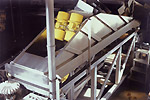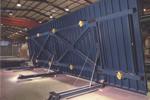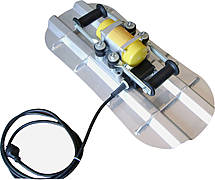- Rebar Chairs & Spacers
- Rebar Placing & Fixing
- Casing Spacers
- Casing End Seals
- Penetration Seals
- Flange Insulating Gasket Kits
- Flange Band Protectors
- Rubber coated u-bolts
- Safety Spray Shields
- Radolid® Protection Caps
- Wall Sleeves
- Hammer Cushion Pads
- Monolithic Insulating Joints
- Meter Service Fitting
- DuoCon Centralizers
- Foreman Night Caps
- Pipe Support Systems
- Corrosion Isolators






External Vibrators for the Concrete Compaction Industry
There are 2 methods of compacting concrete via vibration. Wet-cast concrete gets consolidated by external vibrators mounted to the outside of a mould. This reduces the cohesion and friction between the components. Grains are therefore able to become denser and the enclosed air can move upward and escapes. Dry-cast concrete achieves compaction through external vibrators on top. With this method the concrete gets pressed and the enclosed air of the concrete moves out. This method is for example applied in the production of paving blocks.
There are 2 methods of compacting concrete via vibration. Wet-cast concrete gets consolidated by external vibrators mounted to the outside of a mould. This reduces the cohesion and friction between the components. Grains are therefore able to become denser and the enclosed air can move upward and escapes. Dry-cast concrete achieves compaction through external vibrators on top. With this method the concrete gets pressed and the enclosed air of the concrete moves out. This method is for example applied in the production of paving blocks.
The consolidation of dry-cast concrete
Dry-cast concrete is also used for blocks and pre-fabricated ceillings. During the production, machinery is used to complete the concreting and compacting at the same time. In general the compacting results through external vibrators with a rotational speed of 3000 1/min. The standard required for vibrators used in this situation is extremely high. The reason for this is the very short cycle times in which the vibrators are used, the frequent use of the vibrator during this process and the high forces exerted on the vibrator during the compression process.
Dry-cast concrete is also used for blocks and pre-fabricated ceillings. During the production, machinery is used to complete the concreting and compacting at the same time. In general the compacting results through external vibrators with a rotational speed of 3000 1/min. The standard required for vibrators used in this situation is extremely high. The reason for this is the very short cycle times in which the vibrators are used, the frequent use of the vibrator during this process and the high forces exerted on the vibrator during the compression process.
The compacting of wet-cast concrete
To oscillate wet-cast concrete different frequencies are used. During this process, high oscillation frequencies (100-200Hz) have advantages over low oscillation frequencies (50-60Hz). During higher frequency vibration, the coarse grains move less inside the concrete. Even with long vibration times there is no danger of segregation. In addition to this the liquefaction of the cement is brought about by high oscillations and vibrations. The result of the liquefaction of the cement is a very good compaction of the concrete. During the production of pre-fabricated parts, a vibration frequency of 100 Hz has been implemented. The reasons for a 100Hz frequency are numerous.
To oscillate wet-cast concrete different frequencies are used. During this process, high oscillation frequencies (100-200Hz) have advantages over low oscillation frequencies (50-60Hz). During higher frequency vibration, the coarse grains move less inside the concrete. Even with long vibration times there is no danger of segregation. In addition to this the liquefaction of the cement is brought about by high oscillations and vibrations. The result of the liquefaction of the cement is a very good compaction of the concrete. During the production of pre-fabricated parts, a vibration frequency of 100 Hz has been implemented. The reasons for a 100Hz frequency are numerous.
Innovative Vibrator for ICF Concrete Consolidation
Creating good-quality concrete consolidation is essential for strong, energy-efficient ICF walls. Voids and honeycombing can affect the structural integrity of the walls. Especially the corners and lintels; these are the areas that need the most strength and are the areas where poor consolidation is most likely to occur. These critical areas need adequate vibration. The use of internal vibrators has several negative affects; they get caught in the rebar and the loss of equipment becomes costly to the contractor. With the rise and growth of ICF construction and the emphasis on technical development, BRECON decided to become part of this great innovation. Their team of German Engineers embarked on designing a new hand-held tool that would be imperative and essential in the ICF industry. Vibrating the concrete from the outside to ensure an even distribution of concrete throughout the ICF walls.
Creating good-quality concrete consolidation is essential for strong, energy-efficient ICF walls. Voids and honeycombing can affect the structural integrity of the walls. Especially the corners and lintels; these are the areas that need the most strength and are the areas where poor consolidation is most likely to occur. These critical areas need adequate vibration. The use of internal vibrators has several negative affects; they get caught in the rebar and the loss of equipment becomes costly to the contractor. With the rise and growth of ICF construction and the emphasis on technical development, BRECON decided to become part of this great innovation. Their team of German Engineers embarked on designing a new hand-held tool that would be imperative and essential in the ICF industry. Vibrating the concrete from the outside to ensure an even distribution of concrete throughout the ICF walls.
